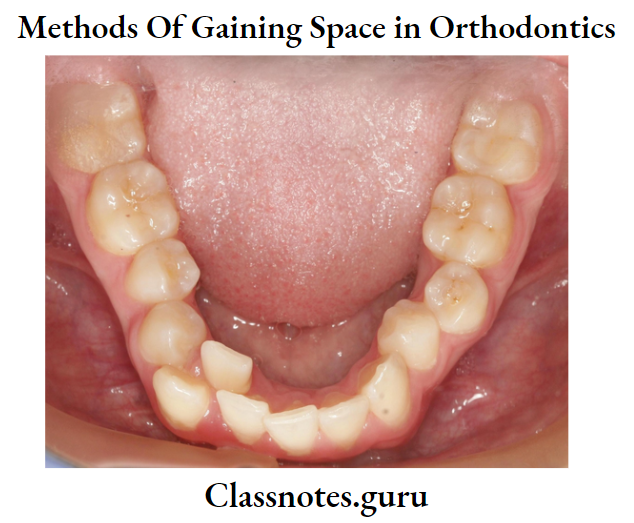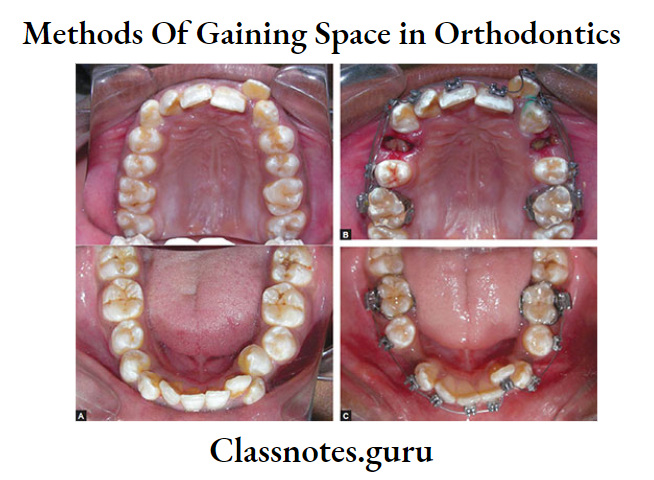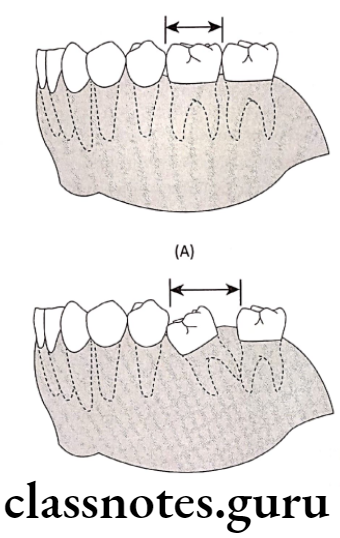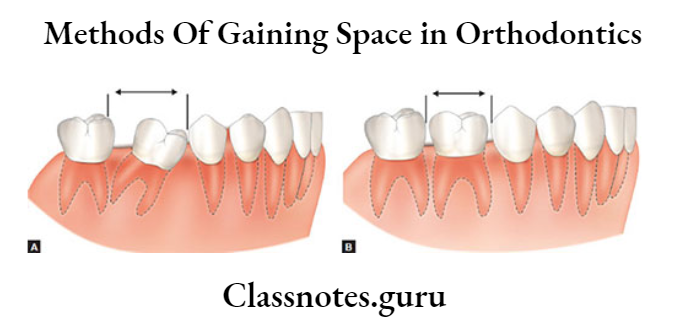Methods Of Gaining Space Important Notes
- Proximal stripping
- Contraindications
- Young patients
- Patient with high caries index
- Contraindications
- Methods of Gaining Space
- Proximal stripping
- Expansion
- Extraction
- Distalization
- Uprighting of molars
- Derotation of posteriors
- Proclination of interiors
Methods Of Gaining Space Long Essays
Question 1. What are therapeutic methods of gaining space? Explain in detail first premolar extraction.
Answer.
Methods Of Gaining Space:
- Proximal stripping
- Expansion
- Extraction
- Distalization
- Uprighting of molars
- Derotation of posteriors
- Proclination of interiors
First Premolar Extraction:
- Extraction forms a main part of all space-gaining procedures
- Extraction is indicated for the correction of
- Crowding
- Anteroposterior dental arch relations
- Vertical problems
- Skeletal jaw deformities
- Presence of supernumerary teeth
- Factors affecting the choice of teeth
- Condition of teeth
- Position of teeth
- Position of crowding
- Premolars are frequently extracted for this purpose
Read And Learn More: Orthodontics Short And Long Essay Question And Answers
First Premolar Extractions:
Reasons:
- To gain space to utilize for correction
- Satisfactory contact between canine and 2nd premolar
- The teeth posterior to it offer adequate anchorage
Indications Of First Premolar Extractions:
- To relieve moderate-severe anterior crowding
- For correction of class 2, division 1, and class 1 bimaxillary protrusion
- In case of > 5mm arch length tooth material discrepancy


Question 2. Explain various methods of gaining space.
Answer.
Proximal stripping:
Synonyms Of Methods Of Gaining Space:
- Approximation
- Slenderization
- Disking and Proximal slicing
Procedure Of Methods Of Gaining Space:
- Proximal surfaces are sliced to reduce the mesiodistal dimensions of teeth
Means:
- Metallic abrasive strips
- Carborundum discs
- Long thin tapered fissure burs
- Followed by fluoride application
Indications Of Methods Of Gaining Space:
- 0-2.5mm – Discrepancy
- Mild to moderate excess tooth material according to Bolton’s analysis
Contraindications Of Methods Of Gaining Space:
- Young patients
- High caries index
- Amount of reduction – less than 50% of enamel
Expansion:
Indications Of Expansion:
- Constricted maxillary arch
- Unilateral/Bilateral crossbite
Types Of Expansion:
- Skeletal
- By splitting mid palatal suture
- Dental
- By jackscrew/springs like coffin spring
Extraction:
- Commonly extracted are premolars
- Provides sufficient space for correction
- Preserves functions and esthetics
Visualization of molars:
- Advantage – Avoids the need for extraction
- Indication – Mild to moderate class 2
- Time – Before the eruption of 2n permanent molar
Uprighting of molars:
- Indication: Mesially tipped molar
- Causes: Premature loss of 2nd deciduous molar
- Extraction of 2nd premolar
Appliances used:
- Molar uprighting springs
- Space regainers

Derotation of Posteriors:
- Rotated posteriors occupy more space
- Derotation of them helps to gain space
- Appliances used:
Incorporating springs/elastics using a force couple

Proclination of interiors:
- Indication: Retroclined interiors
- Precaution: Prevent damage to the soft tissue profile
Methods Of Gaining Space Short Essays
Question 1. Slenderization/Proximal Stripping.
Answer.
Proximal stripping:
- Synonyms:
- Approximation
- Slenderization
- Disking and Proximal slicing
- Procedure:
- Proximal surfaces are sliced to reduce the mesiodistal dimensions of teeth
- Means:
- Metallic abrasive strips
- Carborundum discs
- Long thin tapered fissure burs
- Followed by fluoride application
- Indications:
- 0-2.5mm – Discrepancy
- Mild to moderate excess tooth material according to Bolton’s analysis
- Contradictions:
- Young patients
- High caries index
- Amount of reduction: less than 50% of enamel
Expansion:
- Indications Of Expansion:
- Constricted maxillary arch
- Unilateral/Bilateral crossbite
- Types Of Expansion:
- Skeletal
- By splitting mid palatal suture
- Dental
- By jackscrew/springs like coffin spring
- Skeletal
Extraction:
- Commonly extracted are premolars
- Provides sufficient space for correction
- Preserves functions and esthetics
Visualization of molars:
- Advantage – Avoids the need for extraction
- Indication – Mild to moderate class 2
- Time – Before the eruption of 2nd permanent molar
Uprighting of molars:
- Indication: Mesially tipped molar
- Causes: Premature loss of 2nd deciduous molar
- Extraction of 2nd premolar
Appliances used:
- Molar uprighting springs
- Space regainers
Derotation of posteriors:
- Rotated posteriors occupy more space
- Derotation of them helps to gain space
- Appliances used:
- Incorporating springs/elastics using a force couple
Proclination of interiors:
- Indication: Retroclined interiors
- Precaution: Prevent damage to the soft tissue profile
Question 2. Slenderization/Proximal Stripping.
Answer.
Synonyms Of Proximal Stripping:
- Approximation
- Slenderization
- Disking and Proximal slicing
Procedure Of Proximal Stripping:
- Proximal surfaces are sliced to reduce the mesiodistal dimensions of teeth
Means:
- Metallic abrasive strips
- Carborundum discs
- Long thin tapered fissure burs
- Followed by fluoride application
Indications Of Proximal Stripping:
- 0-2.5mm – Discrepancy
- Mild to moderate excess tooth material according to Bolton’s analysis
Contraindications Of Proximal Stripping:
- Young patients
- High caries index
- Amount of reduction: Less than 50% of enamel
Question 3. Molar distalization
Answer.
Aim: To move molars in a distal direction to gain space
Methods Of Molar distalization:
- Extraoral headgear
- Intra oral Sagittal appliance
- Intraoral magnets
- Open coil spring
- Pendulum appliance
- Headgear
- Consists of a face bow with an inner and outer bow
- Head cap/neck strap
Disadvantage Of Molar distalization:
- Needs patient cooperation
- Has intermittent in their action
Sagittal Appliance:
- Consist of jackscrew positioned parallel to the occlusal plane
- Use only one tooth at a time
Intra-oral magnets
- Consists of repelling magnets
Open coil spring:
- Compressed spring placed between molar and anterior segment
Pendulum appliance:
- Consist of modified Nance button and helix
- Activated by opening the helix
Methods Of Gaining Space Short Questions And Answers
Question 1. Derotations.
Answer.
- Rotated posteriors occupy more space
- Derotation of them helps to gain space
- Appliances used
- Incorporating springs/elastics using a force couple
Question 2. Enumerate methods of Gaining Space.
Answer.
- Methods of Gaining Space
- Proximal stripping
- Expansion
- Extraction
- Distalization
- Uprighting of molars
- Derotations of posterior teeth
- Proclination of anterior
Methods Of Gaining Space Viva Voce
- Visualization is an advanced method of gaining space in recent times
- A mixed dentition period before the eruption of the second permanent molar is the ideal time for distalization
- Proximal stripping requires space of 0-2.5mm
- Bolton’s analysis is done for proximal stripping
- Proclination of interiors creates space
- Slenderization is also called approximation, disking, and proximal slicing
